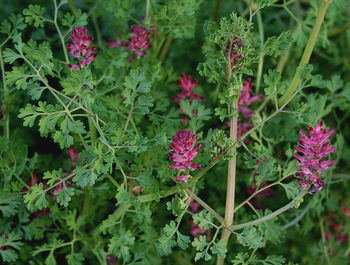Common Fumitory
Other Names : Fumaria officinalis, Beggary, Earth Smoke, Fleur de Terre, Hedge Fumitory, Fumus, Wax Dolls, Vapor, Common fumitory, Drug fumitory, Earth smoke and Earth-smoke, Fumaria, conejitos, gitanillas, hierba de la culebra, fumeterre officinal, erva-moleirinha, Gemeiner Erdrauch, fumaria comune, gewone duivekervel, Duivenkervel, jordrök
low shrub with gray pointed leaves, and from a distance the plant can have the wispy appearance of smoke. Because of this, it received the name “earth smoke.” It’s indigenous of Europe and Asia. It grows in nitrificated places and abandoned cultivations with fresh soil and roadsides. It blooms in early spring and the bloomed plant is harvested at the beginning of blooming (between April and June). The parts of the plant that grow above the ground are used to make medicine.
See also : Indian Fumitory
Contents
Special Precautions of Common Fumitory
- Common Fumitory is poisonous in all parts. Main active ingredients are alkaloids such as protopine, sinactin, cryptopine and some other unknown alkaloids.
- Howard (1987) warns that fumitory is poisonous and should only be used "under the direction of a medical herbalist", but in Europe, no safety problems with its use have been recorded as of 2011. Large doses of protopine in animal models causes excitation and convulsions. Thorough toxicological research on this plant has not been conducted as of 2011. There have been no studies on its safety or effect on pregnant woman, children or elderly
- Avoid its use during pregnant and also by lactating mothers.
- The epilepsy and fit patients should not use it.
- It increases the effect of allopathic medication used for high blood pressure.
- Use this herb under the supervision of a health practitioner.
Properties
Fumitory is an aperient, depurative, cholagogue(stimulating the flow of bile), directic, laxative, sedative, stomachic, sudorific and tonic. It has traditionally been used as a vermifuge, to treat the skin, as a digestive tonic, and in sclerosis of the liver
Health Benefits and Uses of Common Fumitory
The traditional medical uses of fumitory are as a skin treatment for eczema and other eruptions of the skin. The herb is taken as a tea for indigestion, and can be supportive in treating gallbladder and liver conditions.
- Internal use
- Biliary dyskinesia, cholecystitis, cholelithiasis, cirrhosis, eases the symptoms related to liver disorders (weakness, lack of appetite, headaches, nausea, vomit).
- for gallbladder and liver complaints.
- as tea it is used as a spasmolytic for spasmodic complaints in the upper digestive tract, especially in the gallbladder and biliary tract. For treating gallbladder, bile ducts and gastrointestinal tract.
- In addition to anti-spasmodic properties, the drug also regulates the bile flow.
- Hepato-biliary originated headaches.
- Bronchial asthma.
- Skin disorders: dermatosis, eczemas, psoriasis, skin exanthemas.
- Hyperlipidemias, arteriosclerosis prevention.
- Tachycardia and hypertension.
- Thromboembolisms and hyperglobulia prevention.
- Diarrhea.
- Chronic skin conditions. Fumitory is used as a cure for psoriasis, eczema, rash, acne, milk crust and scabies. This application was taken up in conventional medicine and led to the use of synthetic esters of fumaric acid in the (under medical supervision) therapy of psoriasis.
- Also useful for the chronic and itching eczema resulted from liver disease.
- Prepare an infusion by pouring boiling water to 2-3 gm drug and strain it after 20 minutes.
- Before 30 minutes of meals, drink one cup of warm infusion to treat gallbladder complaints.
- It has valuable action on liver and effective for liver problems such as costiveness, jaundice, debility of stomach and scurvy.
- used in Roman times for its blood cleansing activity.
- Being a diaphoretic, it is used to induce sweat.
- It stimulates muscles of intestines and also strengthens peristalsis.
- As a tea, it is an aid for eliminating intestinal parasites.
- This herb also promotes the function of gallbladder and liver.
- As it possesses antispasmodic effect, it helps to normalize bile flow.
- In Germany, this herb is used to treat biliary colic.
- External Use :
- Skin disorders: dermatitis, dandruff and seborrhea, psoriasis (fumaric acid).
- Conjunctivitis : Used as eyewash for treating conjunctivitis.
- Apply the mixture of fumitory and walnut leaves for cuts, wounds and scrapes.
Main Combination
Liver crisis : Desmodium adscendens + Common Fumitory
References
- Piotr Gorecki. Fumaria. In: Hagers Handbuch der pharmazeutischen Praxis. 5. Auflage, Band 5 (Drogen E-O), Springer, Berlin etc. 1993, S. 206–211 ISBN 3-540-52638-2
- Dr. Duke's Phytochemical and Ethnobotanical Databases
